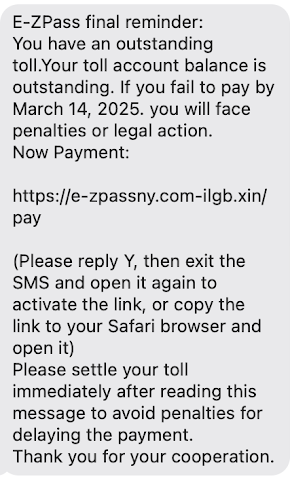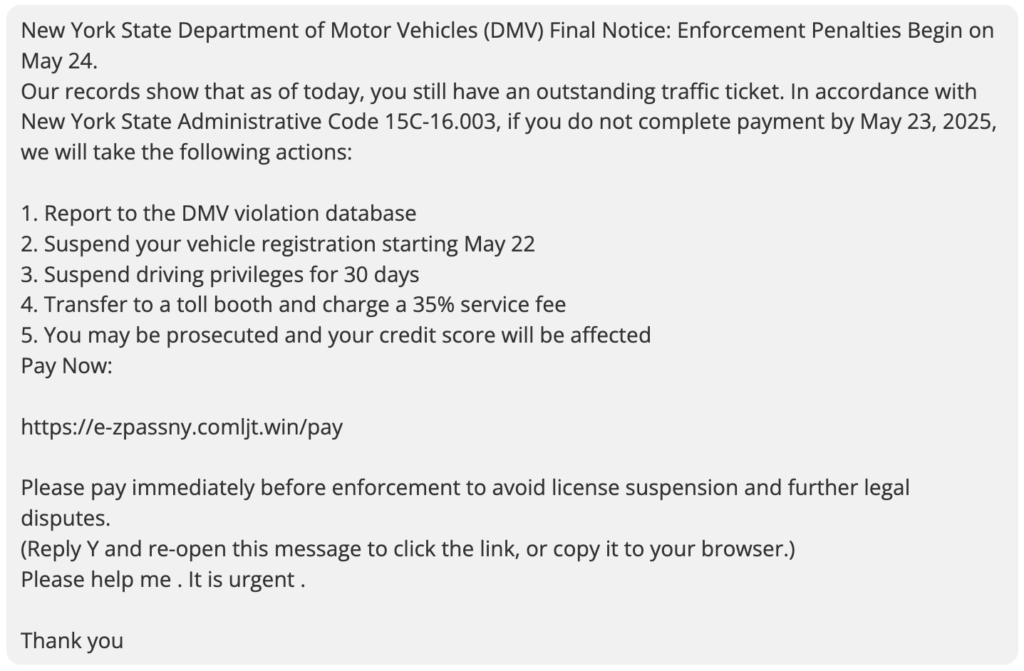A new scam is circulating across the United States in which fraudsters send fake text messages that claim to be from various state departments of motor vehicles (DMVs) or E-ZPass. These messages claim the recipient owes an outstanding payment and threaten to suspend their driver’s license or registration unless they pay immediately.
In April 2024, the FBI’s Internet Crime Complaint Center (IC3) released a Public Service Announcement about this growing threat, which uses a tactic known as smishing. Smishing is a form of phishing conducted via SMS (short message service), or text messaging. While many are familiar with email-based phishing attacks, smishing targets victims directly through their smartphones, often catching people off guard. According to the FBI, smishing is “a social engineering attack using fake text messages to trick people into downloading malware, sharing sensitive information, or sending money to cybercriminals.”
The scam first surfaced in February 2024 and has since spread rapidly across the country. The FBI says that the IC3 has already received more than 60,000 reports related to the scheme. The consequences can be severe; victims who respond to the message may lose money and unknowingly hand over sensitive personal or financial information to cybercriminals.
Although these messages have appeared nationwide, many specifically impersonate the New York DMV, making the scam especially relevant for New York drivers. Authorities in several states, including New York, Pennsylvania, Virginia, Maryland and Indiana, have issued public warnings about the scam’s ongoing threat.
How the Scam Works
The scam begins with a text message that appears to come from a legitimate source such as the DMV or E-ZPass. The message typically claims the recipient owes a fine and must make an immediate payment to avoid serious consequences, such as suspension of their driver’s license or vehicle registration. It often includes a link to a fraudulent payment portal or a phone number to call.
These fake fines are usually small amounts, making the demand seem reasonable and increasing the likelihood that a person will pay without second-guessing. However, the scammers are more focused on collecting the victim’s personal and financial information. When a person submits a payment, they may unknowingly hand over sensitive details such as their name, address, and credit card numbers. In some cases, scammers have even used this data to add victims’ credit cards to digital wallets like Apple Pay or Google Wallet.
It is important to note that receiving one of these messages does not mean that an E-ZPass or DMV account has been compromised. These messages are being sent in bulk to random phone numbers with the hope that at least some recipients will be E-ZPass users and fall for the scam.
Warning Signs of a DMV or Toll Payment Text Scam
Scam messages can be surprisingly convincing and may not always come from an overseas or suspicious-looking phone number. One of the key indicators is the tone. If the message feels alarming, overly urgent, or threatening, it is likely a scam. Many of these communications are poorly written and often include obvious spelling mistakes or grammatical errors.
Scammers frequently try to mimic official sources to gain recipients’ trust. For example, these messages might include fake DMV logos or professional-looking formatting to appear legitimate. They typically demand immediate payment for supposed fines or violations, and they may threaten to suspend driving privileges if action is not taken quickly. Often, they contain suspicious hyperlinks that lead to fraudulent websites designed to steal personal information.
There are several red flags to keep in mind. Unsolicited texts claiming to be from the DMV, particularly those requesting payment or personal information, warrant caution. Watch for threatening language or deadlines that seem unreasonably short, and be wary of links embedded in the message, especially if they look unusual or are shortened. Again, misspellings and poor grammar are often telltale signs of a scam.
To help the public stay informed, the New York DMV has released examples of these fraudulent messages so individuals can more easily recognize and report them. Additional examples provided by Rosenblum Law Firm are featured below to further illustrate how these scams may appear.
Examples:




Steps to Take After Receiving a ‘Smishing’ Message
When a suspicious text message appears to come from the DMV or E-ZPass, the best course of action is to ignore it. Avoid clicking on any links, replying to the message, or calling any phone numbers. Even messages that prompt a response such as “Reply STOP” to unsubscribe, should be avoided - this can be a tactic scammers use to verify that a phone number is active.
These messages are designed to create panic and pressure individuals into acting quickly without thinking. However, legitimate businesses and government agencies do not demand immediate action or threaten a person’s privileges via text. Any message that insists on urgent payment or requests personal information on the spot is almost certainly a scam.
Tips to Stay Safe
If you receive one of these messages, here are some steps you can take to protect yourself.
Don’t Give Out Personal Information
Avoid giving personal information through the phone, text, or email. The Federal Communications Commission (FCC) advises keeping all smart devices and apps updated to the latest versions, installing reputable anti-malware software, and using multi-factor authentication to safeguard online accounts, particularly those related to banking, healthcare, or social media.
Always Verify Before Taking Action
If a message looks suspicious, verify its legitimacy by reaching out directly to the agency or company using contact information from its official website or a trusted source. The New York DMV, along with several other state agencies, has confirmed that it does not send text messages asking for payment or personal information.
If you are uncertain about whether a payment is owed to E-ZPass or another organization, the safest approach is to log in through the official website, such as the DMV’s website, or a verified customer service number. Avoid using any links, phone numbers, or contact details included in the suspicious message. A brief online search or review of recent bills can quickly confirm how to reach the legitimate agency. Taking a few extra minutes to confirm the source can make all the difference in avoiding a scam.
Report the Scam
Report a smishing message as soon as you receive it. Timely reporting plays a crucial role in tracking scam activity and can help protect others from becoming victims. Several official channels are available for reporting these types of scams:
- Forward the message to 7226 to report it to the FCC.
- File a complaint with the Federal Communications Commission (FCC).
- File a complaint with the FBI Internet Crime Complaint Center (IC3).
- Report to the Federal Trade Commission (FTC).
- Report to the New York DMV Fraud Department.
What to Do After Engaging with a Scam
If you have already clicked a link in one of these emails or shared personal information,, remain calm but act quickly. Contact your financial institutions immediately to freeze or closely monitor affected accounts. In addition, update your passwords - especially for E-ZPass, banks, and other sensitive logins - right away, and enable transaction alerts as an added precaution. Regularly review your financial statements to detect unfamiliar charges and monitor for potential signs of identity theft.
FAQs
Are DMV texts a scam?
Yes. Unsolicited text messages that appear to be from the DMV or E-ZPass and demand immediate payment or threaten suspension of a driver’s license or vehicle registration are likely scams. These fraudulent messages are part of a nationwide “smishing” campaign aimed at stealing personal and financial information.
Can I get my money back if I accidentally paid a scammer?
While recovering funds directly from the scammer is unlikely, it is important to contact the bank or credit card company immediately. They may be able to dispute the charge, reverse the transaction, or take steps to secure the account and prevent further harm. Prompt action offers the best chance of minimizing financial loss.
Does the New York DMV send unsolicited text messages?
No. The New York DMV has confirmed that it does not send unsolicited text messages requesting payment or personal information. Any such message purporting to be from the New York DMV is a scam.
What does a spoof text look like?
A spoof text may appear to come from a trusted source like the DMV or E-ZPass. It often contains official-looking logos or formatting, uses urgent or threatening language, and includes links to fraudulent websites. Common warning signs include misspellings, poor grammar, shortened URLs, and pressure to act immediately. Even the phone number it comes from might look legitimate, so don’t trust appearance alone.




